Printed from: https://finalhbks.asgoodasready.com/wildflowers/meadowsweet/
Scientific name: Filipendula ulmaria
Family: Rosaceae (Rose)
Meadowsweet is a perennial herb that grows in damp or wet habitats, like wet woodland, damp meadows and along pond or river edges. It is characteristic of sites where water levels fluctuate and is absent from permanently waterlogged ground.
The common name Meadowsweet derives from the Anglo-Saxon word ‘medu’, which means ‘mead’. It was once used to flavour mead – the drink made from fermented honey.
The first part of the scientific name ‘Filipendula’ comes from Latin and means ‘hanging by a thread’. This refers to the way the root tubers hang on the fibrous roots – a characteristic of this genus. The second part of the scientific name ‘ulmaria’ describes how the leaves of Meadowsweet resemble those of the elm (Ulmus).
Meadowsweet is a member of the rose family (Rosaceae). The main leaves are alternate and occur as pairs of serrate (toothed) leaflets, whose undersides are downy white. Often, pairs of small leaflets alternate with pairs of larger ones. The terminal leaflets at the tip are large and three- to five-lobed.
The plant flowers from June to August and its seeds ripen from August to September. The creamy-yellow flowers are found in clusters, have a very strong, sweet scent and attract many insects. They usually have five petals and numerous long stamens, which give the flower heads the characteristic fuzzy appearance. The almond-like scent of the leaves is quite different from that of the flowers.
Meadowsweet was one of the three most sacred herbs of the druids. Vervain and water-mint were the other two. It has been used as a medicinal plant since ancient times and it remains popular today as a herbal remedy.
Propagation
From seed
Sow seed as soon as they ripen in autumn in moist soil, ideally in a cold frame. Scatter the seed, rake lightly and firm down well. Keep well watered and weeded. When seedlings are large enough to handle, prick them out into individual pots and plant them out in the summer if they have grown enough. If not, keep them in a cold frame for the winter and plant them out in late spring.
By division
Divide the plants in autumn or winter. Larger clumps can be replanted direct into their permanent positions, smaller clumps are better potted up and grown in a cold frame until they are well-rooted. Plant them out in the spring.

